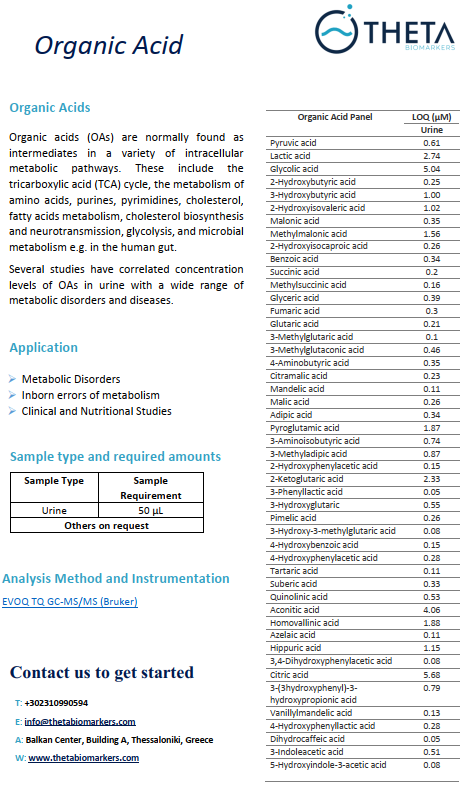Organic Acid Profile
Organic acids, including mono-, di- and tricarboxylic acids, hydroxy-, phenolic- or other nitrogen containing acids are involved, as intermediates, in numerous intracellular metabolic pathways, such as the tricarboxylic acid (TCA) cycle, glycolysis, amino acid metabolism, and the metabolism of purines, pyrimidines, cholesterol, and fatty acids. Numerous studies have shown that organic acids are proven biomarkers of a range of metabolic disorders and diseases, including diabetes II, liver cancer, asthma and chronic obstructive pulmonary disease, inflammatory bowel disease, Crohn’s disease, autism spectrum disorders, pregnancy and other conditions.
Urine is the preferred sample type for organic acid analysis highlighting their dysregulation (Mouskeftara et al.). Our panel offers one of the most comprehensive if not the most comprehensive profile of organic acids in urine.
Applications
What are the essential amino acids?
Amino acids are organic compounds composed mainly of nitrogen, carbon, hydrogen, and oxygen. Our body needs 20 different amino acids for its proper function and nine are considered essential: lysine, valine, histidine, methionine, isoleucine, leucine, phenylalanine, threonine, and tryptophan. Essential amino acids can only be obtained from diet and are the core of many vital processes.
Available Tests
Organic acid analysis in urine
Hydroxyisobutyric acid
Citraconic acid
4-Hydroxybenzoic acid
Nicotinic acid
Glutaric acid
4-Hydroxyphenylacetic acid
Pyruvic acid
3-Methylglutaric acid
Tartaric acid
Lactic acid
3-Methylglutaconic acid
Suberic acid
Xanthurenic acid
4-Aminobutyric acid
Quinolinic acid
Kynurenic acid
Citramalic acid
Aconitic acid
Glycolic acid
Mandelic acid
Homovallinic acid
2-Hydroxybutyric acid
Malic acid
Azelaic acid
3-Hydroxybutyric acid
Adipic acid
Hippuric acid
2-Hydroxyisovaleric acid
4-Phenylbutyric acid
3,4-Dihydroxyphenylacetic
3-Methyl-2-oxovaleric acid
Pyroglutamic acid
Citric acid
Malonic acid
3-Aminoisobutyric acid
Homogentisic acid
Methylmalonic acid
3-Methyladipic acid
3-(3-hydroxyphenyl)-3-hydroxypropionic acid
2-Hydroxyisocaproic acid
2-Hydroxyphenylacetic acid
Sebacic acid
Benzoic acid
2-Ketoglutaric acid Vallylmandelic acid
Succinic acid
3-Phenyllactic acid
4-Hydroxyphenyllactic acid
Methylsuccinic acid
3-Hydroxyglutaric acid
Dihydrocaffeic acid
Glyceric acid
Pimelic acid
Indole-3-acetic acid
Fumaric acid
3-Hydroxy-3-methylglutaric acid
5-Hydroxyindole-3-acetic acid
Related Articles
Analysis of urinary organic acids by gas chromatography tandem mass spectrometry method for metabolic profiling applications, Mouskeftara, T. et al.
Lab Report Writing – an Introduction
Lorem ipsum dolor sit amet, consectetur adipisicing elit, sed do eiusmod tempor incididunt ut labore et dolore magna aliqua. Ut enim ad minim veniam, quis nostrud exercitation ullamco laboris nisi ut aliquip ex ea commodo consequat duis aute irure dolor in
Where can I go to provide a sample for testing?
Our country possesses approximately 170 billion barrels of oil that can be recovered with today’s technology. Of that number, 165 billion barrels are located in the oil sands.
What happens to my sample once I have provided it?
Our country possesses approximately 170 billion barrels of oil that can be recovered with today’s technology. Of that number, 165 billion barrels are located in the oil sands.
How long does testing typically take before results are available?
Our country possesses approximately 170 billion barrels of oil that can be recovered with today’s technology. Of that number, 165 billion barrels are located in the oil sands.
What will laboratory testing cost me?
Our country possesses approximately 170 billion barrels of oil that can be recovered with today’s technology. Of that number, 165 billion barrels are located in the oil sands.

